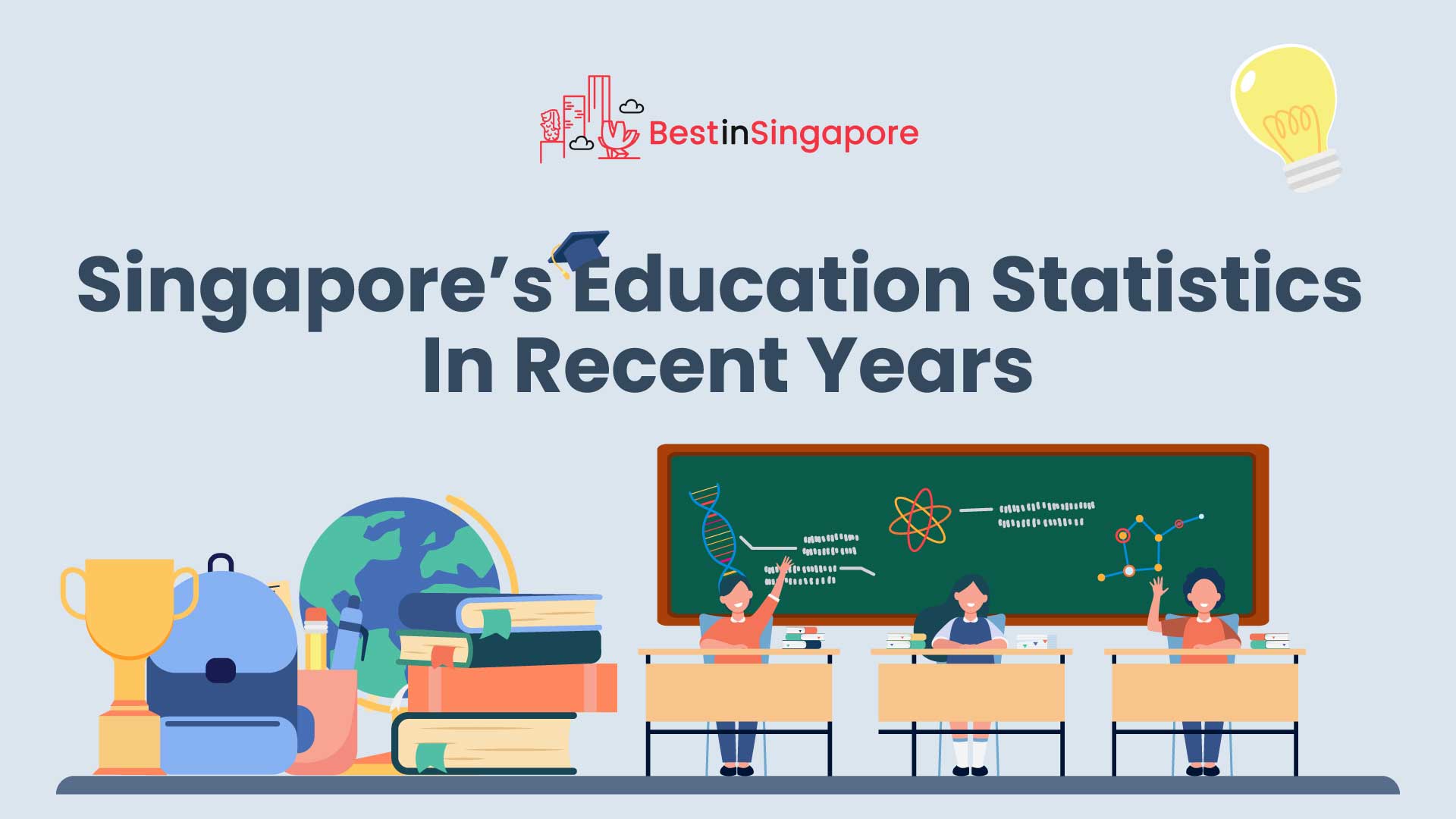Singapore’s Education Statistics In Recent Years
Key Insights
⦁ Primary education is compulsory in Singapore.
⦁ Between 2016 and 2020, the percentage of students going from primary to secondary school ⦁ has remained at 98.4%.
⦁ An average Singaporean student is ⦁ 20 months ahead in Math and 10 months ahead in English subjects compared to other developed countries.
⦁ In 2020, the country’s literacy rate among students 15 years old and above was 97.1%.
⦁ By 2020, Singapore residents aged 25 years and up received 11.3 years of schooling on average.
⦁ The 2018 OECD Programme for International Student Assessment showed Singapore as the 2nd top-rated country after China.
⦁ Around 20% of Singapore’s national budget is spent on the education sector.
⦁ The Singapore government’s recurrent expenditure on education amounts to 12.04 billion SGD.
⦁ A 2021 survey by the Times Higher Education in Asia ranked the National University of Singapore as 3rd, and Nanyang Technological University as 5th.
⦁ 87.4% of 7,360 Polytechnic graduates in 2020 were employed within six months of graduating.
The Structure of Singapore Education
The country’s education system has three stages: primary, secondary, and post-secondary. Children aged seven to 12 years old are required to attend primary education for six years.
The primary education core curriculum centers on Math, the English language, and a Mother Tongue language. Singapore’s education system has a bilingual policy for students to both appreciate their multi-cultural heritage and to develop real-world communication skills.
The secondary education level offers three courses in accordance with the student’s academic progress. All three of them require at least four-year studies and are designed to match the student’s interests and aptitude for particular courses.
Singapore’s post-secondary education provides amore diverse in terms of interests and aptitude. Pre-university education can be obtained either at two-year junior colleges or at three-year centralizedinstitutes.
Students with creative pursuits and athletic skills can opt for specializededucation either at the School of the Arts Singapore or at the Singapore Sports School. Diplomas from these schools are of the International Baccalaureate or the Diploma in Business Studies kinds.
Those who want to pursue a more hands-on and progressive full-time diploma course can enroll at the country’s Polytechnics. Students who want to take this educational route need O-level qualifications.
O levels (shortened for the Singapore-Cambridge General Certificate of Education Ordinary Level) are taken by the 4th or 5th year of a student’s secondary education. An approximate 30,000 students take this test annually.
Polytechnics have part-time programmes designed for adult learners as well. Working adults with relevant work experience can also be accepted via the Polytechnic Early Admissions Exercise.
Singapore has six publicly-funded Autonomous Universities with two different approaches to education. The first type is more academic-based and research-oriented, and the other emphasizes hands-on experience and exposure to various industries.
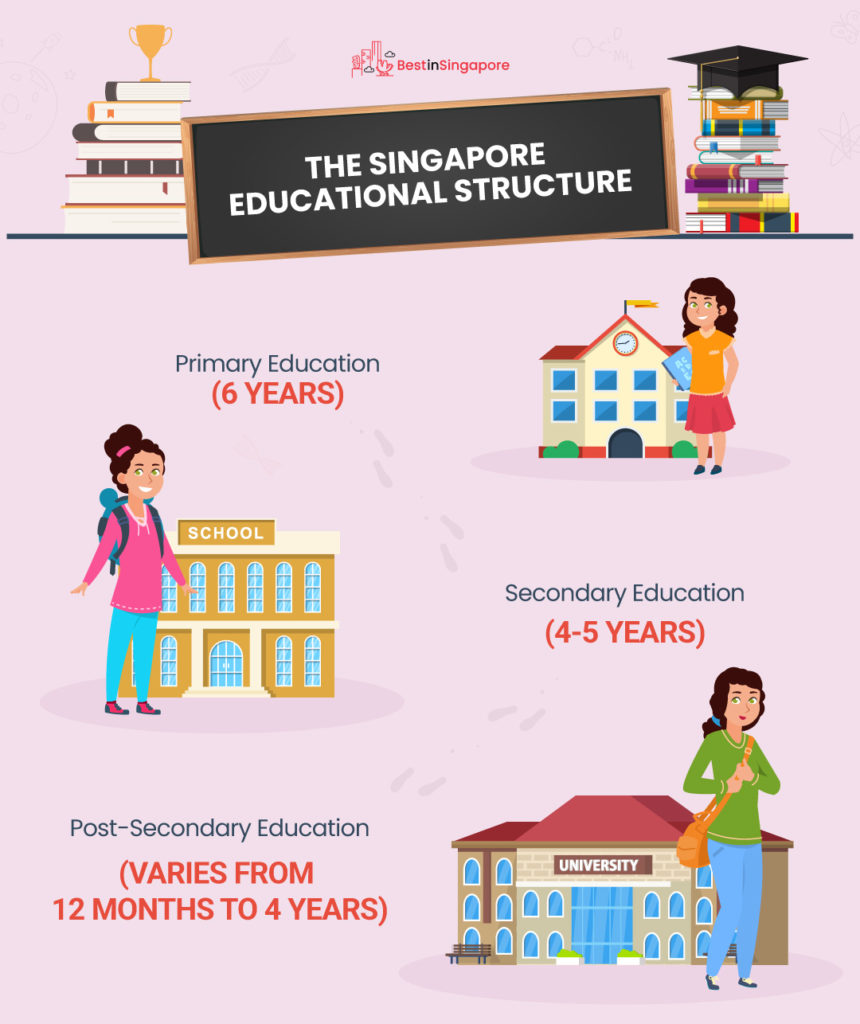
How Singapore Students Performed In The Last Couple of Years
Singapore’s education statistics have been consistently scoring high in the past couple of years compared to other countries. According to a 2018 industry insight from Professionals in International Education, an average Singaporean student is 20 months ahead in Math and 10 months ahead in English subjects.
The global competence of Singapore students has been well-documented by OECD since 2018. In the same year, the global competence test in Singapore showed its students’ performance as one of the best among PISA-participating countries and economies.
Other high competence (among PISA-participating countries) indicators using Singapore student indexes are as follows:
⦁ The students’ ⦁ self-efficacy about global issues in Singapore
⦁ The students’ ⦁ awareness of intercultural communication in Singapore
⦁ The students’ ⦁ agency on global issues in Singapore.
In 2020, the country’s literacy rate among students 15 years old and above was 97.1%. Singapore’s male literacy rate in the same year was 98.5% while its female literacy rate was 95.8% (all figures taken from the Department of Statistics Singapore site).
In 2020, the average male Singaporean student had 11.7 years of education while women had 10.9 years.
Singapore residents (both men and women) who were 25 years or older during the time of the survey revealed the mean years of schooling they received was 11.3.
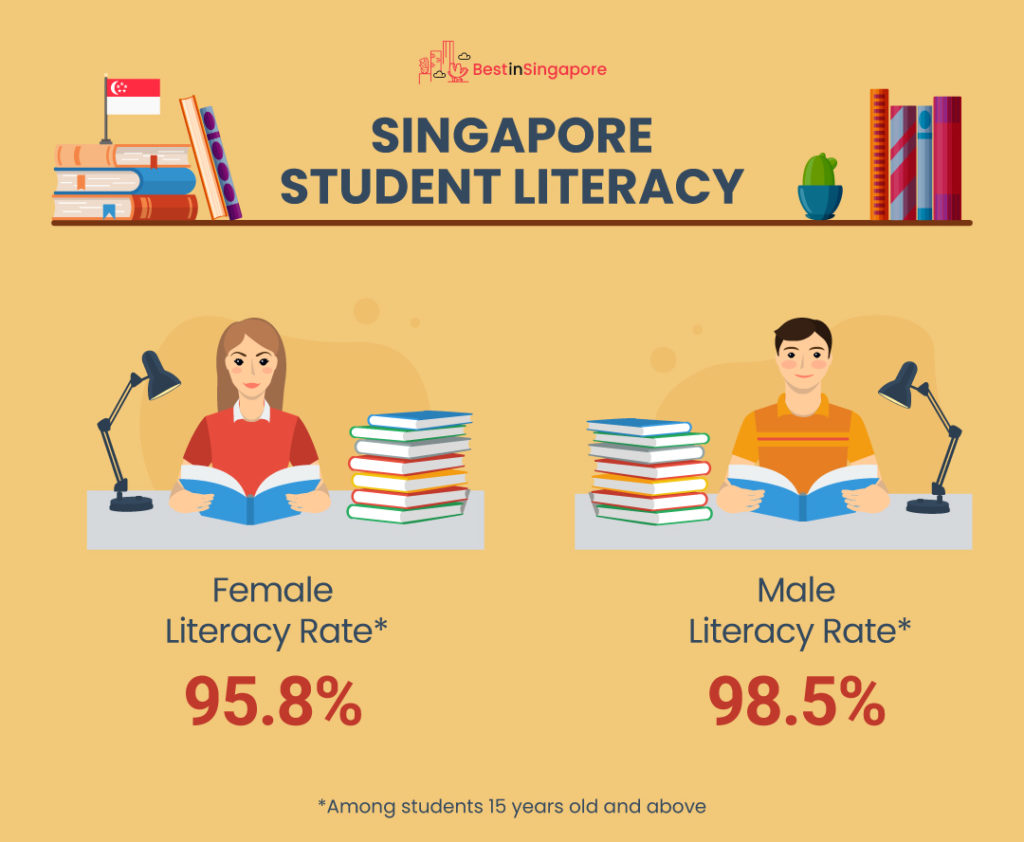
Singapore was the 2nd top-ranking country after China according to the 2018 study done by the OECD Programme for International Student Assessment (PISA). Taking into account students’ literacy in the field of reading, mathematics, and science, Singapore garnered an average score of 556, 22 points lower than that of China.
A 2021 survey by the Times Higher Education in Asia shows two Singapore universities ranking 3rd and 5th in the region. The third-ranked National University of Singapore scored 83.1 while the 5th-ranked Nanyang Technological University scored 75.7.
The rankings were calculated using criteria for:
⦁ Teaching (30%) or learning environment,
⦁ Research (30%) or volume income and reputation,
⦁ Citations (30%) or research influence
⦁ Industry income (2.5%) or innovation
⦁ International Outlook (7.5%) or staff, students, and research.
In 2019, the country had 19,173 University graduates. Polytechnic graduates totalled 3,798 in the same year.
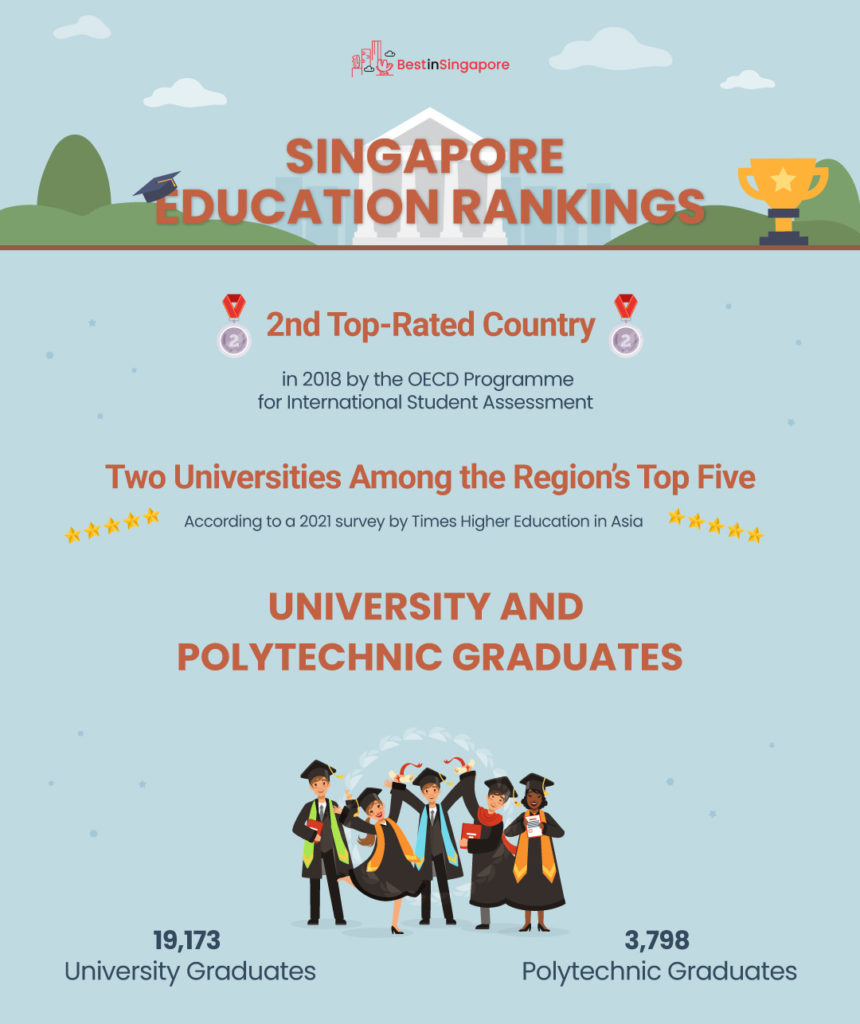
What Makes Singapore’s Education System Effective?
Owing to its emphasis on life-long learning, around 20% of Singapore’s national budget is spent on the education sector. The Singapore government’s recurrent expenditure on education amounts to 12.04 billion SGD.
Between financial years 2010 to 2019, its expenditure on primary schools was 2.00 billion SGD. As for its secondary schools and junior colleges, the government set aside 3.11 billion SGD for the same financial years.
In 2019, there was a recurrent government expenditure amounting to around 22,000 SGD per student in a publicly-funded full-time course.

The highly-centralized educational system of the country has been successful at recruiting the top 5% of its graduates as teachers in the past years. Prof Sing Kong Lee, vice-president of Nanyang Technological University, described in a BBC feature how all teachers are trained at the National Institute of Education in Singapore as a sustainable approach to continuously improve its educational system.
All teachers undergo extensive training on the Singapore curriculum while at the institute. Depending on their level of education upon entering, they will receive either a diploma or degree course.
The Ministry of Education also provides the following key elements to ensure high-quality teachers:
⦁ Recruitment stipend – equivalent to 60% of a teacher’s salary while undergoing training to ensure commitment to reaching for at least 3 years.
⦁ Close working relationship between the insistute and the schools – a master teacher is assigned to a new teacher for several years.
⦁ Annual professional development – all Singapore teachers are entitled to 100 hours of professional development every year that could lead toward higher degrees and further knowledge on subject matters.
⦁ Teacher growth support funding – there’s a fund at every school that supports the growth and development of teachers which include going to other countries to study their educational systems.
⦁ Performance evaluation – an annual appraisal of a teacher’s performance is done based on their contribution to the academe, their colleagues, and their schools. Outstanding evaluations are further compensated with bonuses.
⦁ Nurturing career paths – the annual assessment also identifies and encourages teachers’ career development and paths: as a master teacher, curriculum speciaist/researcher, or school leader. Salary increase and further training to become school leaders are included.
There’s a bilingual policy that’s the cornerstone of Singapore’s primary school education. Students with a higher aptitude for Mother Tongue Language can opt to do further studies once they reach Secondary Education levels.
All secondary schools in Singapore aim to support their students’ interests and skills with the holistic Learning for Life and the Applied Learning Programmes. They are meant to complement core academic studies while teaching life skills and presenting opportunities to pursue an education that’s in line with their interests and talents.
Employment Rates Among Fresh Post-Secondary Graduates of Singapore
The 2020 Polytechnic Graduate Employment Survey is a joint study by Nanyang Polytechnic, Ngee Ann Polytechnic, Republic Polytechnic, Singapore Polytechnic, and Temasek Polytechnic. It showed how Singapore’s Polytechnics graduates have found employment even with the pandemic in the equation.
There were 7,360 polytechnic graduates who participated in the survey. 87.4% of them were employed within six months after they graduated.
Among fresh graduates, 56.4% of the October 2020 survey respondents were in
the labour force six months after completing their final exams. As for Post-National Service graduates, 42.3% became part of the labour force upon completion of their full-time National Service between April 2019 and March 2020.
Full-time employees make up 52% of them while 31.6% were temporarily employed or in part-time job capacities. Around 50% of these part-time employees are either currently pursuing further studies or plan to do so soon.
Those who started their own businesses and have accepted job offers make up 2.9% of the survey respondents. Meanwhile, 14.6% are unemployed with 3.4% of them currently jobless but with immediate plans to start work.
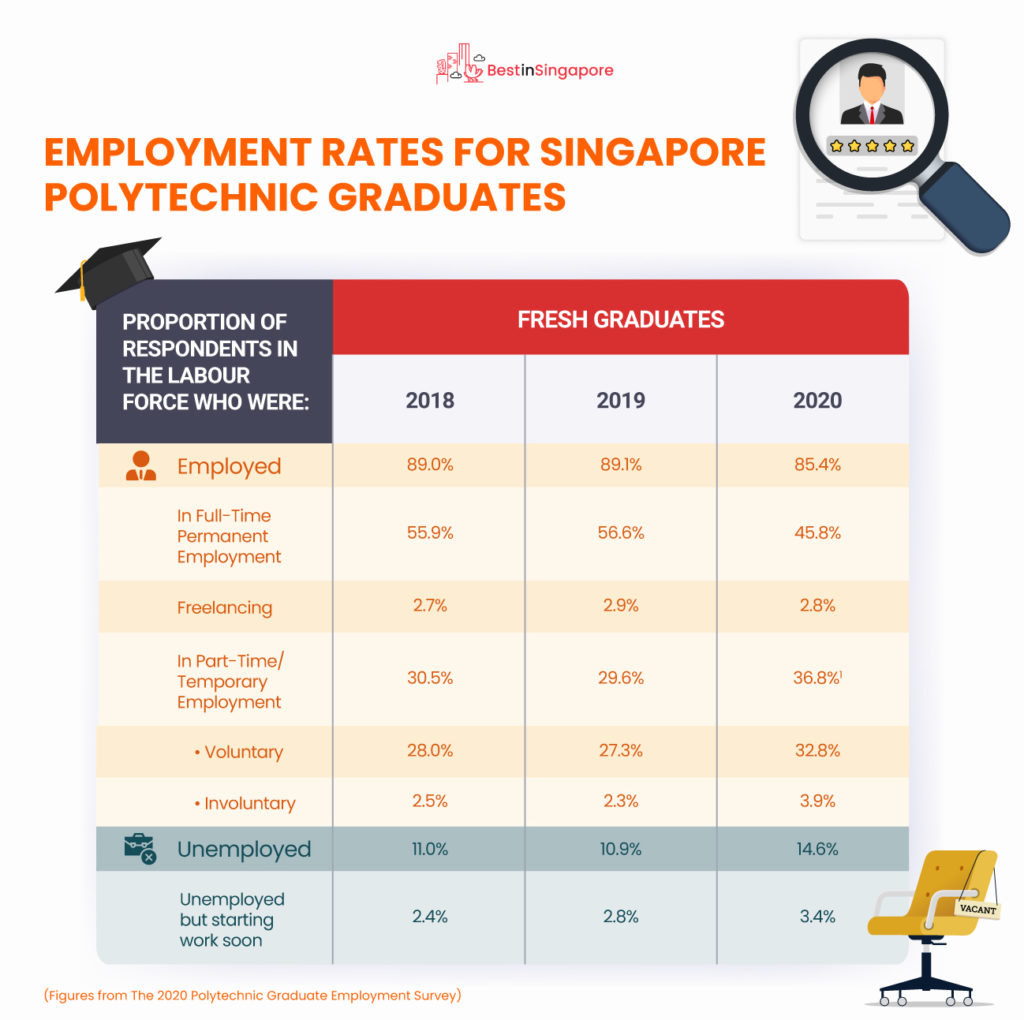
However, care must be taken to include the probability of guaranteed employment because of certain courses taken by fresh graduates. As a Dollars & Sense article points out, surveys like the one mentioned above don’t necessarily paint a clear picture of equal job opportunities.
For instance, comparing graduates of Bachelor of Arts with Bachelor of Dental Surgery from the National University in Singapore would show glaring differences in their full-time employment rates. NUS Bachelor of Arts graduates have a 61.9% employment rate compared to 100% employed Bachelor of Dental Surgery graduates.
But with the pandemic affecting Singapore’s current labour market climate, the government has stepped up to help fresh graduates and new workers in mid-2020.
The Singapore government created a Fortitude Budget that promises to create over 40,000 jobs to improve the country’s economic situation. This budget is part of a 2 billion SGD package aiming to address economic recession and unemployment.
The budget is called the SGUnited Jobs and Skills Package and plans to create around 100,000 job opportunities. These opportunities include 30,000 skills-based training placements and 25,000 traineeship programmes.
Initiatives like this from the government reflect Singapore’s emphasis on lifelong learning as an important continuation of the first two decades of a student’s education.
Notes:
https://www.moe.gov.sg/about-us/publications/education-statistics-digest
https://www.singstat.gov.sg/find-data/search-by-theme/population/education-language-spoken-and-literacy/latest-data
https://www.moe.gov.sg/-/media/files/about-us/education-statistics-digest-2020.pdf?la=en&hash=C5E45EEA6E424D9749F617A4D88A171F6E20AB9A
https://www.statista.com/topics/5766/education-in-singapore/
https://www.ceicdata.com/en/singapore/education-statistics
https://www.oecd.org/pisa/publications/pisa-2018-results.htm
https://www.nationmaster.com/country-info/profiles/Singapore/Education
https://www.k12academics.com/Education%20Worldwide/Education%20in%20Singapore/education-statistics-singapore
https://www.moe.gov.sg/-/media/files/about-us/education-statistics-digest-2020.pdf?la=en&hash=C5E45EEA6E424D9749F617A4D88A171F6E20AB9A
https://www.statista.com/topics/5766/education-in-singapore/
https://blog.thepienews.com/2018/11/what-the-world-has-to-learn-from-singapores-education-system/
https://www.np.edu.sg/media/Documents/Releases-Advisories/2021/Polytechnic%20Graduates%20Continue%20to%20Find%20Jobs%20Amidst%20COVID-19.pdf
https://gpseducation.oecd.org/CountryProfile?primaryCountry=SGP&treshold=10&topic=PI
https://asiasociety.org/global-cities-education-network/how-singapore-developed-high-quality-teacher-workforce

